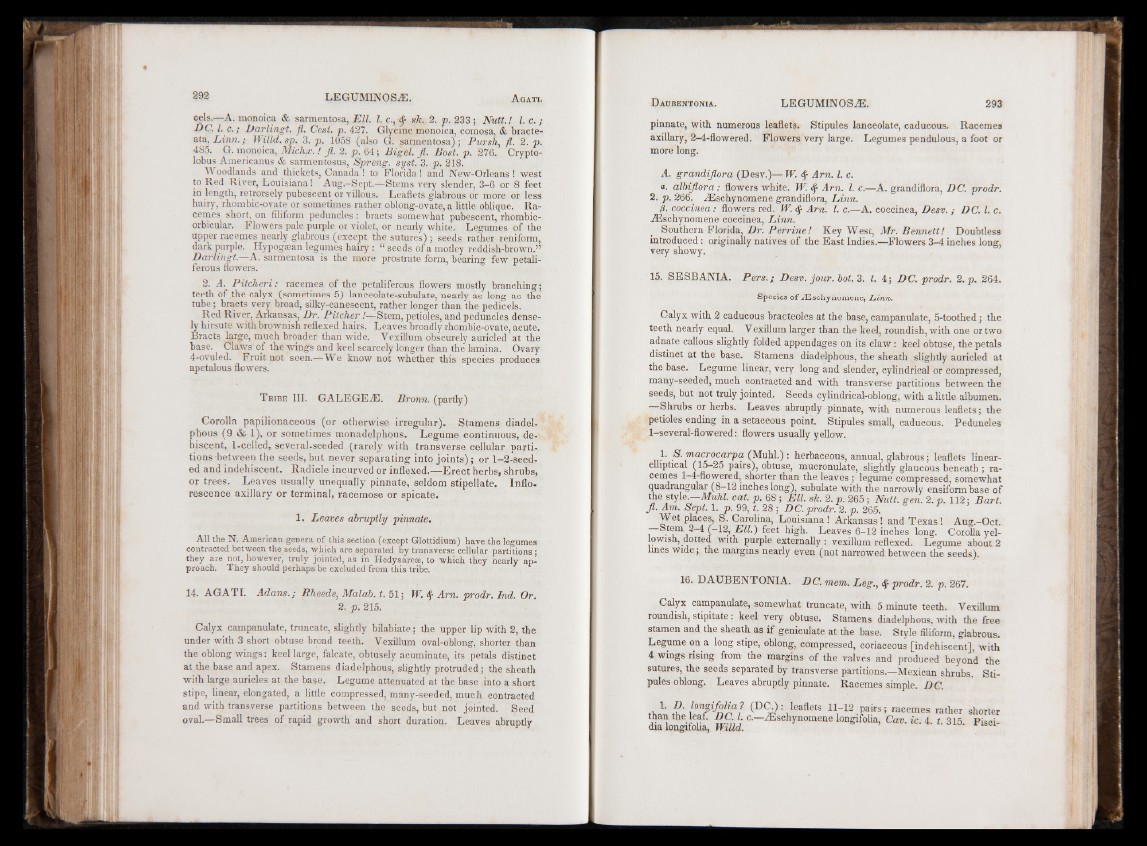
cels.—A. monoica & sarmentosa, Ell. 1. c., '& sk. 2. p. 233; Nutt.! 1. c. ;
DC. 1. c.; Darlingt. fl. Cest. p. 427. Glycine monoica, comosa, & bracte-
ata, L in n .; Willd. sp. 3. p. 1058 (also G. sarmentosa); Pursh, fl. 2. p.
485. G. monoica, Michx. ! fl. 2. p. 64; Bigel. fl. Host. p. 276. Crypto-
lobus Americanus & sarmentosus, Spreng. syst. 3. p. 218.
Woodlands and thickets, Canada! to Florida! and New-Orleans ! west
to Red River, Louisiana! Aug.-Sept.—Stems very slender, 3-6 or 8 feet
in length, retrorsely pubescent or villous. Leaflets glabrous or more or less
hairy, rhombic-ovate or sometimes rather oblong-ovate, a little oblique. Racemes
short, on filiform peduncles: bracts somewhat pubescent, rhombic-
orbicular. Flowers pale purple or violet, or nearly white. Legumes of the
upper racemes nearly glabrous (except the sutures) ; seeds rather reniform,
dark purple. Hypogsean legumes hairy : “ seeds of a motley reddish-brown.”
Darlingt.—A. sarmentosa is the more prostrate form, bearing few petali-
ferous flowers.
2. A. Pitcheri: racemes of the petaliferous flowers mostly branching;
teeth of the calyx (sometimes 5) lanceolate-subulate, nearly as long as the
tube; bracts very broad, silky-canescent, rather longer than the pedicels.
Red River, Arkansas, Dr. Pitcher !—Stem, petioles, and peduncles densely
hirsute with brownish reflexed hairs. Leaves broadly rhombic-ovate, acute.
Bracts large, much broader than wide. Vexillum obscurely auricled at the
base. Claws of the wings and keel scarcely longer than the lamina. Ovary
4-ovuled. Fruit not seen.—We know not whether this species produces
apetalous flowers.
T ribe III. GALEGEÆ. JBronn. (partly)
Corolla papilionaceous (or otherwise irregular). Stamens diadel-
phous (9 & 1), or sometimes monadelphous. Legume continuous, dehiscent,
1-celled, several-seeded (rarely with transverse cellular parti-
tions-between the seeds, but never separating into joints); or 1- 2 -seed-
ed and indéhiscent. Radicle incurved or inflexed.—Erect herbs, shrubs,
or trees. Leaves usually unequally pinnate, seldom stipellate. Inflo-
rescence axillary or terminal, racemose or spicate.
1. Leaves abruptly pinnate.
All the N. American genera of this section (except Glottidium) have the legumes
contracted between the seeds, which are separated by transverse cellular partitions ;
they are not, however, truly jointed, as in Hedysarese, to which they nearly approach.
They should perhaps be excluded from this tribe.
14. AGATI. Adans. ; Rheede, Malab. t. 51 ; W. <$■ Am. prodr. Ind. Or.
2. p. 215.
Calyx campanulate, truncate, slightly bilabiate ; the upper lip with 2, the
under with 3 short obtuse broad teeth. Vexillum oval-oblong, shorter than
the oblong wings: keel large, falcate, obtusely acuminate, its petals distinct
at the base and apex. Stamens diadelphous, slightly protruded; the sheath
with large auricles at the base. Legume attenuated at the base into a short
stipe, linear, elongated, a little compressed, many-seeded, much contracted
and with transverse partitions between the seeds, but not jointed. Seed
oval.—Small trees of rapid growth and short duration. Leaves abruptly
pinnate, with numerous leaflets. Stipules lanceolate, caducous. Racemes
axillary, 2-4-flowered. Flowers very large. Legumes pendulous, a foot or
more long.
A. grandiflora (Desv.)— W. ty Am . 1. c.
a. albiflora: flowers white. W. $ Am . 1. c.—A. grandiflora, DC. prodr.
2. p. 266. .<Eschynomene grandiflora, Linn.
ft- coccinea: flowers red. W. Arh. 1. c.—A. coccinea, Desv. ; DC. 1. c.
iEschynomene coccinea, Linn.
Southern Florida. Dr. Perrine! Key West, Mr. Bennett! Doubtless
introduced: originally natives of the East Indies.—Flowers 3-4 inches long,
very showy.
15. SESBANIA. Pers-i Desv. jour. bot. 3. t. 4; DC. prodr. 2. p. 264.
Species of iEschyhomene, Linn.
Calyx with 2 caducous bracteoles at the base, campanulate, 5-toothed; the
teeth nearly equal. Vexillum larger than the keel, roundish, with one or two
adnate callous slightly folded appendages on its claw: keel obtuse, the petals
distinct at the base. Stamens diadelphous, the sheath slightly auricled at
the base. Legume linear, very long and slender, cylindrical or compressed,
many-seeded, much contracted and with transverse partitions between the
seeds, but not truly jointed. Seeds cylindrical-oblong, with a little albumen.
Shrubs or herbs. Leaves abruptly pinnate, with numerous leaflets; the
petioles ending in a setaceous point. Stipules small, caducous. Peduncles
1-several-flowered: flowers usually yellow.
J ' S. macrocarpa (Muhl.): herbaceous, annual, glabrous; leaflets linear-
elliptical (15-25 pairs), obtuse, mucronulate, slightly glaucous beneath ; racemes
1-4-flowered, shorter than the leaves ; legume compressed, somewhat
quadrangular (8—12 inches long), subulate with the narrowly ensiform base of
the style.— Muhl. cat. p. 68 ; Ell. sk. 2. p. 265; Nutt. gen. 2. p. 112: Bart,
fl. Am. Sept. 1. p. 99, t. 28 ; DC.prodr. 2. p. 265.
Wet places, S. Carolina, Louisiana! Arkansas! and Texas! Aug.-Oct.
i . -E^.) feet high. Leaves 6-12 inches long. Corolla yellowish,
dotted with purple externally: vexillum reflexed. Legume about 2
lines wide; the margins nearly even (not narrowed between the seeds).
16. DAUBENTONIA. DC. mem. Leg., prodr. 2. p. 267.
Calyx campanulate, somewhat truncate, with 5 minute teeth. Vexillum
roundish, stipitate: keel very obtuse. Stamens diadelphous, with the free
stamen and the sheath as if geniculate at the base. Style filiform, glabrous.
Legume on a long stipe, oblong, compressed, coriaceous [indehiscent], with
4 wings rising from the margins of the valves and produced beyond the
sutures, the seeds separated by transverse partitions.—Mexican shrubs. Stipules
oblong. Leaves abruptly pinnate. Racemes simple. DC.
pan.a j rainer snorter
than the leaf. DC. 1. c.—Æschynomene longifolia, ’6av. ic. 4. t 315 p;sf.j
dia longuolia, Willd. '